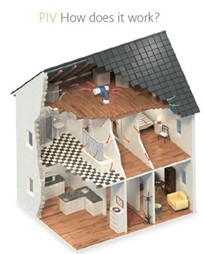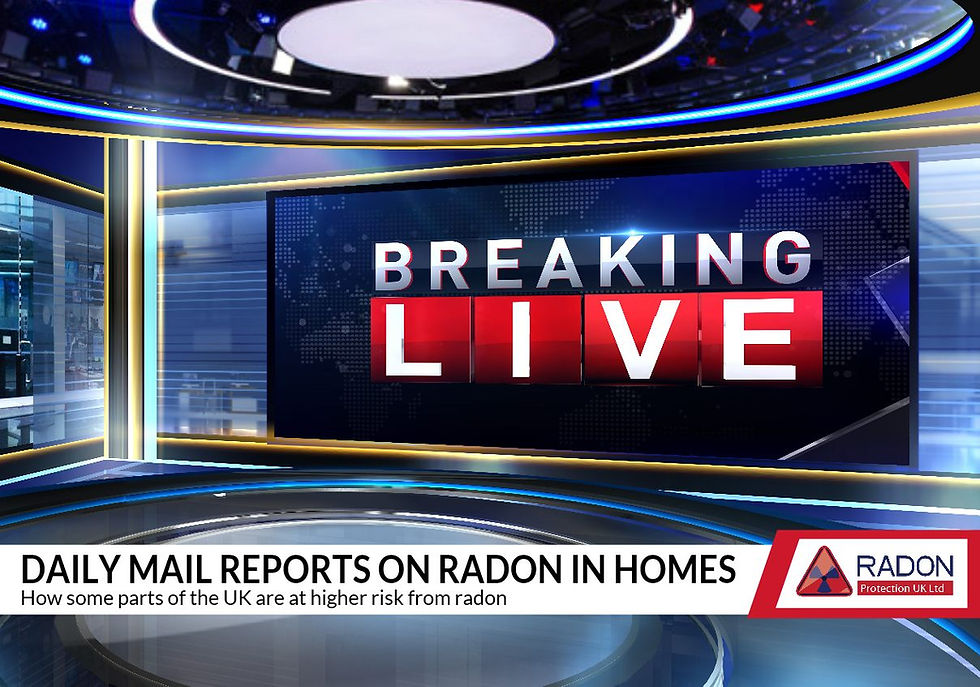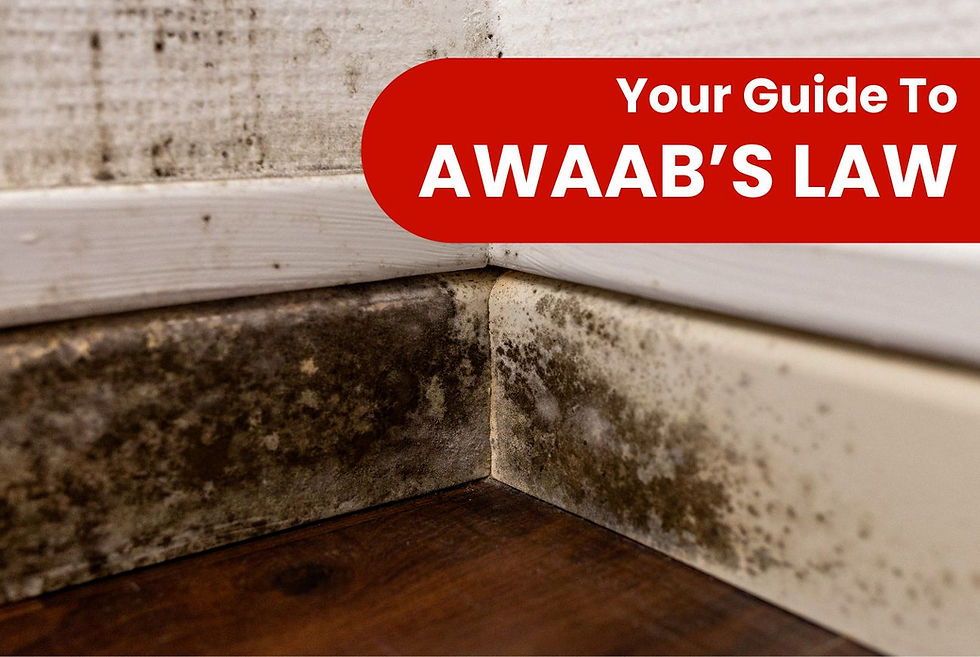The Hidden Risk in UK Homes: How Radon Gas Affects Your Family’s Health
- Radon Protection UK

- Sep 24
- 5 min read
Why is Radon Gas a Hidden Risk in UK Homes?
Radon gas in UK homes is a silent and invisible threat that can have serious health consequences if left unaddressed. This naturally occurring radioactive gas comes from the breakdown of uranium in soil and rocks under properties, entering buildings through cracks, gaps, and service ducts. Because radon is colourless, odourless, and tasteless, most residents are unaware of its presence, yet it contributes to over 1,100 lung cancer deaths annually in the UK, particularly affecting smokers and ex-smokers UKHSACRCE.
Radon exposure risk varies by location, with some UK regions, including parts of the South West, the Midlands and Wales, showing a higher potential for elevated radon levels due to underlying geology UK Radon Map UKHSA Radon Map. Since radon’s presence cannot be detected without testing, the gas poses a hidden health hazard in many homes and schools.
What Are the Health Risks of Radon Gas?
The primary health risk of radon gas is lung cancer. When radon gas is inhaled, it emits ionising radiation that damages lung tissue over time. The risk increases with sustained exposure to high radon levels, especially for current and former smokers Cancer Research UK. Although only about 5% of lung cancers in the UK are linked to radon, this makes radon the second leading cause of lung cancer after smoking UKHSA.
The UK Government advises that the lower the radon concentration indoors, the lower the health risk. There is no known safe threshold, but remedial action is recommended for properties with radon levels above the "Action Level" of 200 Bq/m³ annually UK Radon AssociationHSE IRR17.
How Do I Know if My Home, Workplace or School Has Dangerous Levels of Radon?

Radon gas levels differ widely across the UK, influenced mainly by the local geology. The UK Health Security Agency (UKHSA) and British Geological Survey (BGS) provide an updated radon map showing areas at higher risk of elevated radon gas infiltration, such as Cornwall, parts of Wales, and the South West UKHSA Radon Map.
However, radon can be present at high levels even outside these designated areas, making radon testing essential for all homeowners, business owners, tenants, and schools concerned about safety. Radon testing is simple, affordable, and is the only reliable way to assess radon levels indoors UK Radon Association.
How is Radon Testing Done in UK Homes?

Radon testing typically involves placing detectors—either passive devices like charcoal canisters or alpha track detectors—in the lowest lived-in areas of a building for a recommended period (often three months or more). These detectors measure radon levels over time to provide an average annual concentration in Becquerels per cubic metre (Bq/m³) UK Radon Guidance.
Testing should follow these steps:
Identify most occupied rooms or floors.
Place detectors away from drafts, windows, or heat sources.
Leave detectors undisturbed for the testing period.
Send detectors to an accredited lab for analysis.
Review results to determine if mitigation is needed.
Radon Protection UK offers professional radon testing services designed to meet these standards, with readings interpreted according to UKHSA guidance Radon Protection UK.
What Can Be Done to Reduce Radon Levels? What Are Radon Sumps and Positive Input Ventilation (PIV)?
If testing indicates radon levels above the recommended limit, mitigation measures can significantly reduce indoor radon concentrations.
Radon Sump Systems
A radon sump is a common and highly effective mitigation method. It involves installing a sump beneath the building’s floor slab or within a cavity to draw radon gas up from beneath the property and safely vent it outdoors using a fan system. This reduces radon ingress by creating lower pressure beneath the floor, blocking gas entry BRE BR 211.
The installation process includes:
Drilling or creating a sump pit below the floor.
Installing a sealed pipe connected to a fan.
Venting radon gas safely above the building’s roofline or away from property
Sealing all floor cracks and entry points around the sump.
Positive Input Ventilation (PIV)
PIV systems work by introducing fresh, filtered air into the home, creating a positive pressure environment that helps reduce radon infiltration. This is particularly useful in homes with suspended floors or poorly ventilated basements. While PIV is not as commonly used as sump systems, it can be part of a comprehensive radon mitigation strategy UK Radon Association.
Are New Buildings in the UK Required to Have Radon Protection?
Yes. UK Building Regulations require new builds, extensions, and conversions in radon-affected areas to incorporate specific radon protective measures. This includes installing a radon membrane (a damp-proof barrier), and where needed, active systems like radon sumps or ventilated subfloor voids to reduce radon ingress to safe levels BRE BR 211UK Building Regs.
These regulations are designed to prevent future radon health risks by mitigating radon exposure from the ground up during construction.
Protect Your Home and Family from Radon Gas Today
Radon gas in UK homes is a real and often overlooked health risk that requires urgent attention from homeowners, business owners, tenants, and schools. Regular radon testing is the only way to uncover this hidden danger, and effective mitigation methods such as radon sumps and Positive Input Ventilation (PIV) can safeguard your family’s health.
Don’t wait to act
Contact Radon Protection UK for reliable radon testing and expert mitigation solutions tailored to your property or commercial building. Protect your home, workplace, or school with trusted radon mitigation professionals today. Radon Protection UK.
Frequently Asked Questions (FAQs)
What is radon gas?
Radon is a naturally occurring radioactive gas produced by the breakdown of uranium in soil and rocks. It can accumulate indoors and pose health risks.
How do I test for radon in my home?
Radon testing involves placing detectors in the most occupied areas for up to 3 months, then sending them for lab analysis.
What health risks does radon gas pose?
Long-term exposure to high radon levels increases the risk of lung cancer, especially in smokers or ex-smokers.
What is a radon sump?
A radon sump is a system installed under floors to extract radon gas and vent it safely outside, reducing indoor levels.
Are new UK buildings required to have radon protection?
Yes, new builds in radon-affected areas must follow Building Regulations requiring radon barriers and mitigation measures.
#radongasUK #radonawareness #radonhealthrisks #homesafetyUK #radonmitigation #RadonProtectionUK #radontesting #radonsump #PositiveInputVentilation #PIV #lungcancerrisk #UKhomesafety #radonrisk #radonprotection #UKradon #indoorairquality #smokershealth #radonmapUK #buildingregulations
References & Sources
UK Health Security Agency (UKHSA) and British Geological Survey (BGS) updated radon map for Great Britain https://www.ukradon.org https://www.gov.uk/government/news/ukhsa-and-bgs-publish-updated-radon-map-for-great-britain
The Radon Council / UK Radon Association guide on testing and mitigation https://radonassociation.co.uk/guide-to-radon/introduction/
Cancer Research UK on radon health risks https://www.cancerresearchuk.org/about-cancer/causes-of-cancer/air-pollution-radiation-and-cancer/can-radon-gas-cause-cancer
Building Research Establishment (BRE) radon protection and regulations https://bre.ac/insights/navigating-radon-protection-a-focus-on-regulations-for-new-buildings/
Ionising Radiations Regulations 2017 (IRR17) and UK Building Regulations Approved Document C https://www.hse.gov.uk/radiation/ionising/ionising-radiations-regulations.htm https://www.gov.uk/guidance/building-regulations
Radon Protection UK services and expertise https://www.radonprotectionuk.com










Comments